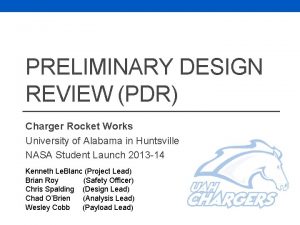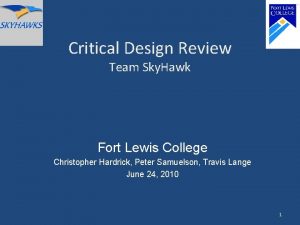Team Sky Hawk Preliminary Design Review Fort Lewis










- Slides: 10

Team Sky. Hawk Preliminary Design Review Fort Lewis College Christopher Hardrick, Peter Samuelson, Travis Lange June 14, 2010

Mission Overview – Primary Objectives • Collect atmospheric radiation levels • Capture video of the flight • Use photodiodes to collect visible and UV light intensities

Radiation • We expect that as altitude increases, the collection of radioactive particles will increase • We expect this because the atmosphere in general scatters radioactive particles. With the increase in altitude, there is less atmosphere to scatter radiation. Geiger counter

Video • We want to have a visible video of the flight up to compare to our video recording UV intensities. • We are hoping to be able to run two cameras on our ITX board, if we are unable to we will have the two cameras alternate when they are taking video. Pico ITX board to be used for video processing

Video with a filter • We want to run a diode that detects ozone levels and see how the ozone changes at different altitudes. • Ozone strongly absorbs UV-B and UV-C, between 100 to 400 nm and more strongly around 280 nm. • By placing a filter on one of the cameras we should be able to compare the visible video to the data of a photodiode collecting intensities in the same spectrum.

Subsystem Requirements - Power - We have a 14. 8 V Lithium Polymer battery - Calibrate temperature, pressure, and accelerometer sensors. - What requirements do you have for each subsystem. - We need the battery to last for the entire trip. If the sensors and cameras take too much power then we won’t make it. - The computer must be capable of running the geiger counter and cameras and have enough storage capacity.

Test Plans - What type of testing can be performed on your payload pre-flight? - We will put the payload in a vacuum jar to simulate high altitude. - We will place our payload in a -80 C freezer for 2 hours. - We will test the length of time that the battery can supply power. - We will also perform a standard drop test of the entire payload. Hobos for data collection during testing

Parts List - Geiger counter Carbon Fiber for structure material External DVD drive to install Windows on our ITX board Photo diodes to detect visible and UV spectrum USB hub Circuit Boards UV Optical Filter Estimated Total Costs: < $700 External DVD drive to install our OS on our ITX board

Management

• Conclusions – Issues and concerns – Power – May not have enough to run everything at once – Making sure that all of our parts work – The carbon fiber might need additional structural support



















